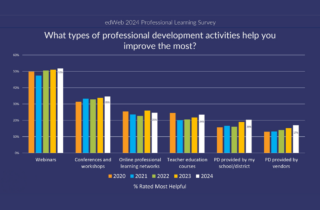While the required implementation of the Science of Reading (SOR) appears to be a phenomenon that has swept across state legislatures in recent years, the truth is that it has been a “culmination of decades of research into literacy,” according to Dr. Roland Good, a leading literacy expert who is also Co-founder of Acadience Learning and an original author of the DIBELS early literacy assessment.
Maybe you remember the ELIZA chatbot or when IBM’s Deep Blue defeated the chess whiz Garry Kasparov. You were probably around for the arrival of Siri, the virtual assistant designed to answer our most pressing questions. A common element of these remarkable events was artificial intelligence (AI)—once a thing of science fiction, now a reality. It’s been around for a while, scaling in the 2020s across fields, including education, where it has transformative potential.
The future is here. Artificial intelligence is part of almost every area of society, including education, so it’s time to take a serious look at it. How can AI help teachers and administrators?
Each year, CoSN conducts a national survey among education technology leaders to assess the current state of technology innovation across multiple school systems. Five specific current challenges were identified in the 2024 survey results: Artificial Intelligence (AI), Cybersecurity, Student Well-Being, Digital Equity, and Interoperability.
Is this scenario familiar? The administration decides that the staff need professional development to integrate a new SEL approach into the classroom. They know that teachers need more than one day of seminars to adjust their classroom methods, so leadership provides training over several weeks. Once the school year begins, administrators observe the teachers to check their progress, but only a few have integrated the SEL approach into their lessons. The professional development, despite the in-depth training, wasn’t impactful enough.
It’s a long-proven truth that some students need tutoring outside the classroom, which was especially shown during the pandemic. For many students, this means the difference between success and failure. But how does one go about helping students get the tutoring they need?
We are in dramatic times, according to Dr. Christina Kishimoto, Founder and CEO of Voice4Equity, LLC and Clinical Professor at the University of Southern California. In the past decade, public school classrooms transformed from having a majority of white students to mostly students of color. We have a diverse student body full of aspiring young minds who include LGBTQ, multiracial, multicultural, and multilingual identities. No other time in U.S. history has this been more evident.
School safety is about more than guarding against disruption. It includes creating a culture where the entire school community thrives. Establishing a safe school environment is a strategic effort that requires district commitment and investment.
L.K. Monroe, education leader and former superintendent of the Alameda County Office of Education, has launched UnboxED Solutions to provide a trusted voice for high-quality educational products and services. Her UnboxED “picks” align with her VALUES: solutions that are value-aligned, accessible, leading-edge, useful, effective, and supportive. edWeb.net is one of the first education solutions she has chosen to unbox! View the short video below.
edWeb has been conducting an annual professional learning survey with our members since 2016. It’s an important way we benchmark our members’ needs and assessment of our edWeb services and the state of professional learning in general. The results have been very consistent over those years, even with the COVID-19 pandemic. If anything, the need… read more →











